Key takeaways:
- Personalization in music enhances the emotional connection between artists and fans through tailored experiences and direct engagement.
- Effective personalization strategies for record labels include leveraging audience data, segmenting audiences, and utilizing social media for authentic interactions.
- Building artist-fan connections relies on authenticity, direct engagement, and sharing exclusive content to create a sense of intimacy and community.
- Measuring the success of personalization strategies involves tracking KPIs, analyzing social media engagement, and gathering direct feedback from fans.
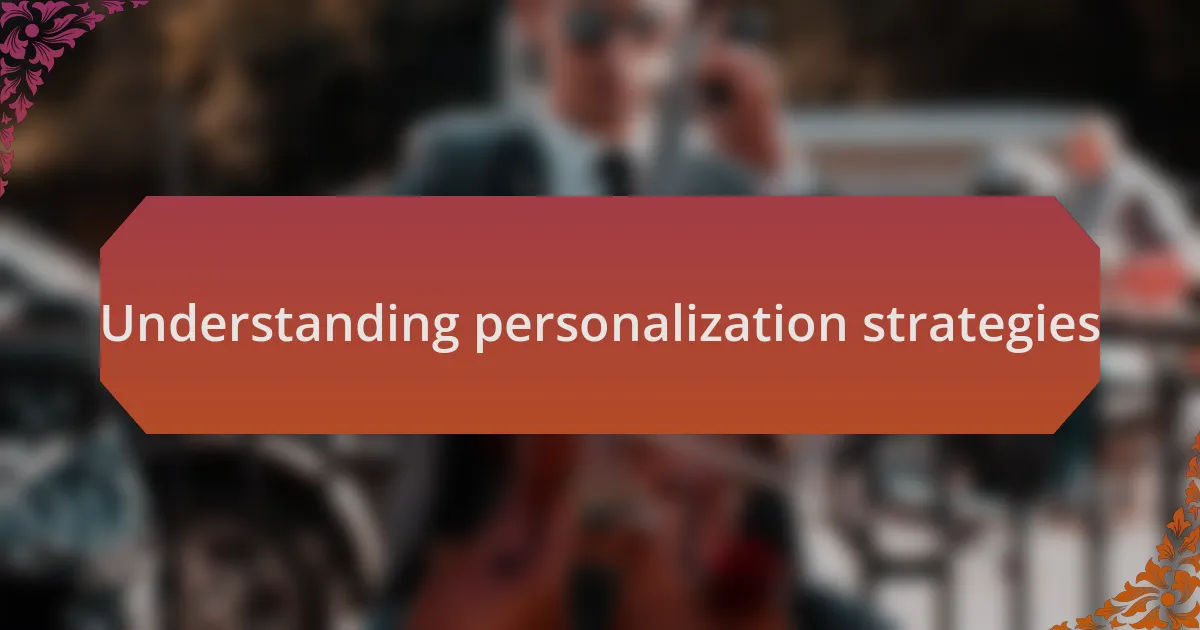
Understanding personalization strategies
When I first began exploring personalization strategies, it struck me how deeply they connect with a listener’s journey. Have you ever wondered why a particular artist resonates with you? It often comes down to the tailored experiences created around their music, whether that’s through song recommendations or targeted social media engagement.
One memorable moment for me was discovering an indie artist through a personalized Spotify playlist. The algorithm wasn’t just throwing random songs at me; it felt as though it knew my music taste intimately. It made me realize how vital it is for labels to curate experiences that cater to individual preferences, enhancing the connection between the artist and the audience.
As I delved deeper into this topic, I encountered the concept of dynamic content, where interactions change based on user data. This idea can seem daunting, but it has the potential to foster genuine relationships. Imagine receiving exclusive behind-the-scenes content from your favorite artist; wouldn’t that feel special? Understanding these strategies allows labels to create meaningful interactions, ultimately leading to a more loyal fan base.
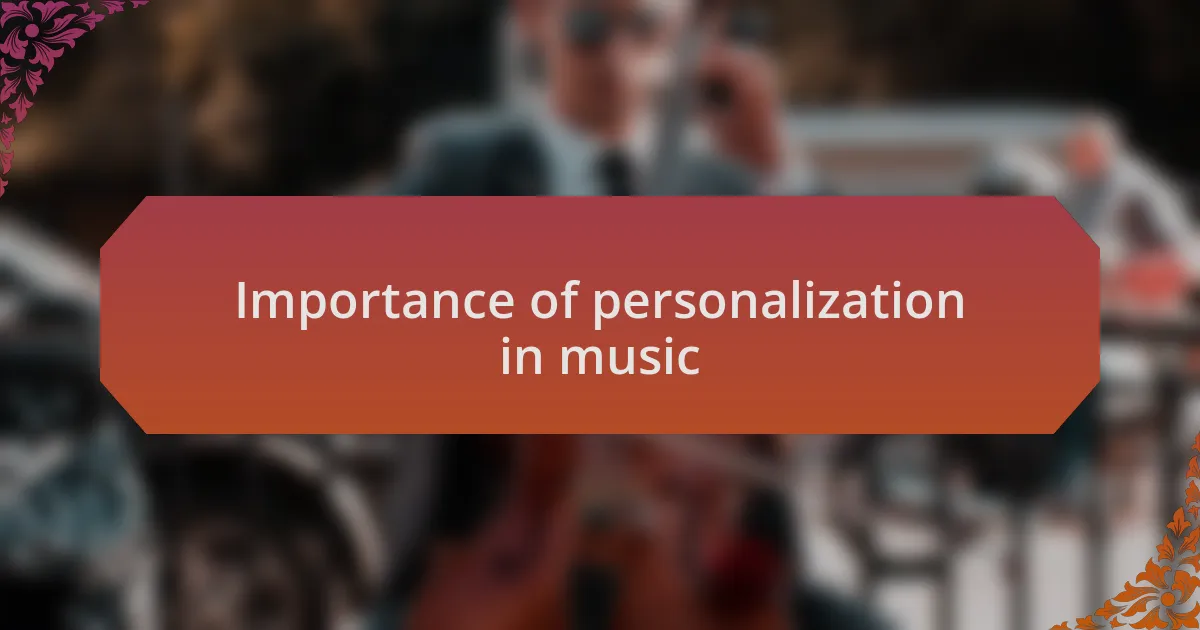
Importance of personalization in music
Personalization in music isn’t just a marketing tactic; it’s a way to forge a deeper bond between artists and fans. I remember last summer, attending a local festival where I stumbled upon a band that was recommended to me through an app. The experience felt personal, as if that app knew I’d enjoy their sound. That connection made me not just a casual listener, but a dedicated fan eager to support them in any way I could.
When an artist takes time to engage personally with their audience—be it through tailored content or direct communication—it creates a sense of belonging. I often think back to when I received a message from a small artist thanking me for my support. It wasn’t a generic response; it was heartfelt and genuine. That moment reinforced my loyalty and made me feel like I wasn’t just another face in the crowd, but part of their journey.
Furthermore, consider how personalized playlists can create a unique musical experience tailored to emotions or occasions. It’s fascinating how music becomes the soundtrack of our lives, shaping our moods and memories. I find myself often curating my playlists based on specific feelings or moments, and discovering new tracks that fit just right. This level of attention to how music intersects with life events is an essential element for labels looking to resonate with listeners on a personal level.
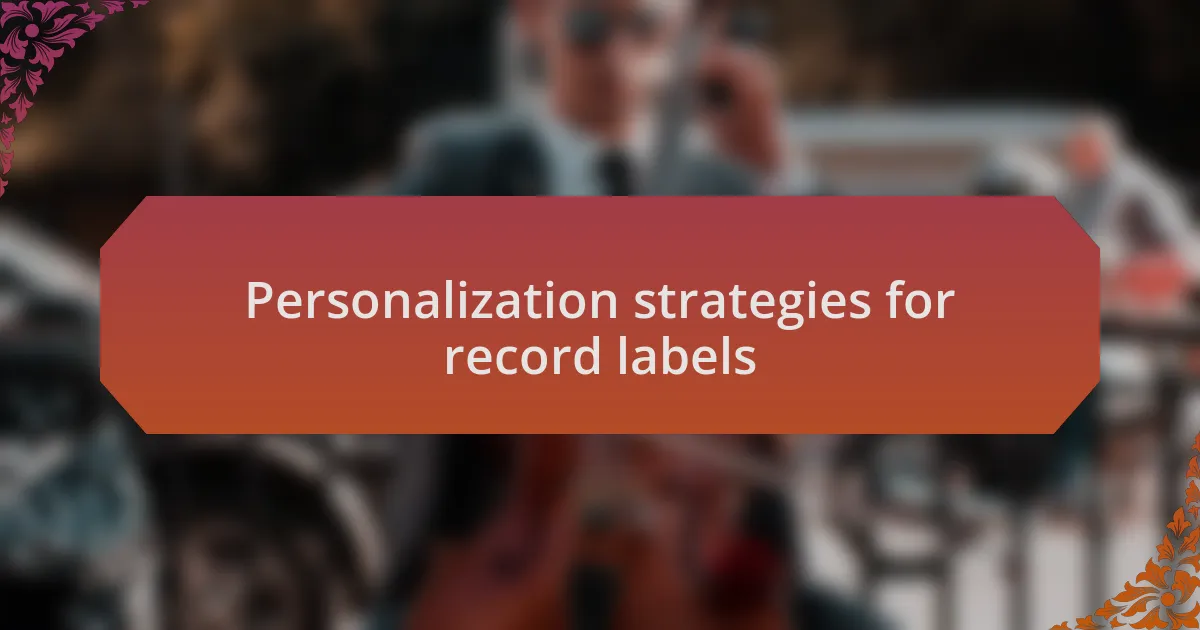
Personalization strategies for record labels
To truly grasp the power of personalization strategies, record labels must tap into the unique narratives behind their artists. For instance, I recall a label that showcased behind-the-scenes videos featuring not just the music but also the stories of struggle and triumph that shaped their artists. This approach transformed the audience’s perception, creating connections that felt deeply personal. Wouldn’t you agree that knowing the story behind a song can intensify the listening experience?
Another effective strategy is segmenting audiences based on listening habits and preferences. I once received a custom email from a label highlighting upcoming shows by artists I had previously shown interest in. That level of tailored communication made the label feel more like a friend than a business. How often do we appreciate a reminder that speaks just to us, rather than a generic announcement?
Lastly, leveraging social media platforms for personalized interactions can make a world of difference. I remember participating in a live Q&A session where fans could ask the artist anything. This direct engagement not only humanized the artist but also allowed fans to feel involved in their creative process. Isn’t it amazing how such simple interactions can create loyalty and excitement?

Analyzing your target audience
Understanding your target audience is a crucial step in crafting effective personalization strategies. I remember a time when I worked with a label that conducted in-depth surveys to gather insights about their listeners. They discovered not only age demographics but also emotional connections to specific genres and artists. This wealth of information transformed their marketing approach, allowing them to tailor campaigns that resonated on a deeper level. Have you ever felt an artist’s music just “gets” you? That’s the kind of connection we want!
Taking a closer look at audience engagement metrics can also reveal valuable patterns. When I examined the analytics of a record label’s social media, I was surprised to see which posts sparked the most interaction. It wasn’t the polished promotional material; it was the heartfelt stories shared by fans about how certain songs impacted their lives. This insight led to a pivot in their content strategy, emphasizing authentic storytelling. Don’t you think it’s fascinating how people connect over shared experiences in music?
Lastly, exploring various audience segments can uncover niches you might have overlooked. I once collaborated with a label that identified a passionate sub-group of fans who were particularly enthusiastic about vinyl releases. By targeting this segment with exclusive offers and personalized communication, they fostered a community around physical music formats. How often do we neglect these devoted fans simply because they exist outside the mainstream? Recognizing and nurturing these unique segments can build loyalty and engagement that is truly invaluable.
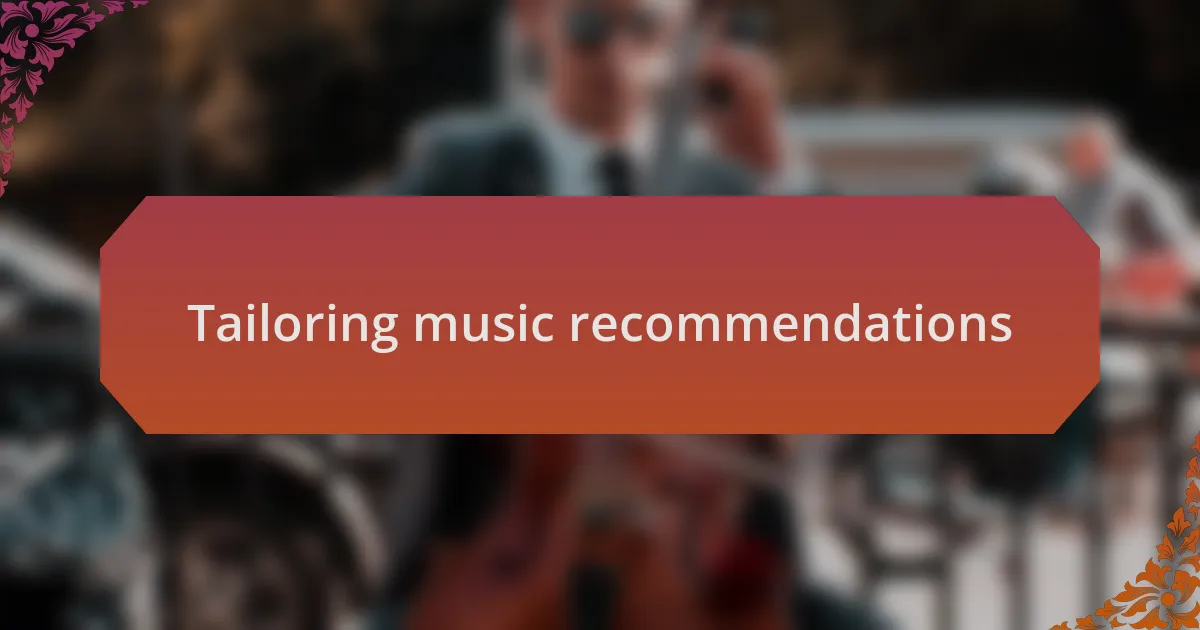
Tailoring music recommendations
Tailoring music recommendations starts with understanding the unique tastes of each listener. I recall a time when I experimented with personalized playlists based on user activity, and the results were eye-opening. By analyzing the listening habits of individuals, I could curate specific tracks that not only matched their favored genres but also introduced them to fresh sounds that resonated with their emotional state at that moment. Isn’t it incredible how the right song at the right time can change your whole day?
In my experience, collaboration with data analytics tools has been essential in refining recommendations. For instance, I once partnered with a team that utilized algorithms to identify listener patterns and preferences, allowing us to suggest songs that felt almost like a musical conversation. When I observed listeners react positively to unexpected genres appearing in their feed, I realized that this element of surprise often deepens their relationship with music. How can we harness this element of serendipity in our recommendations?
Moreover, I believe that personal stories play a huge role in connecting fans with specific tracks. I remember sharing a heartfelt moment with a fan who told me about a particular song that had helped them through tough times. By creating a platform where listeners could share their own stories and connecting them to related music, we fostered not just recommendations but a deeper emotional bond between the artist and the audience. Isn’t that the true power of music—the ability to bring people together through shared experiences?
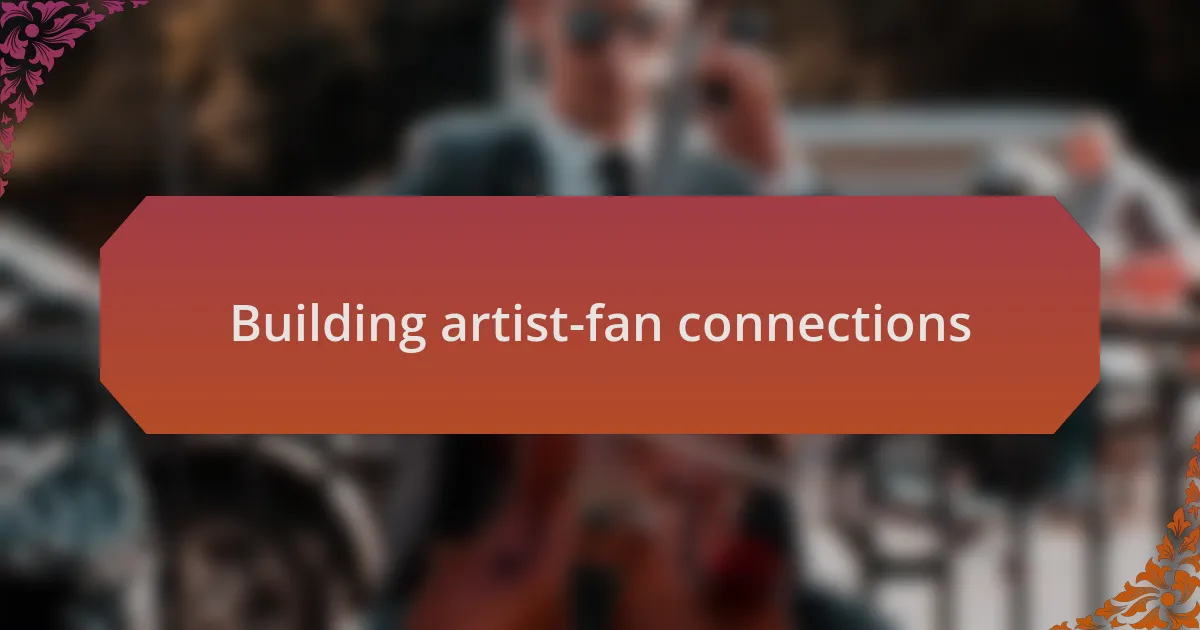
Building artist-fan connections
When it comes to building artist-fan connections, I’ve always found that authenticity is key. I once attended an intimate acoustic show where the artist genuinely shared their creative journey with us between songs. Hearing their personal stories and struggles turned a mere performance into a shared experience, allowing us to feel like we were part of their journey. Just think—how often do we connect through vulnerability?
Creating opportunities for fans to engage directly with artists can also enhance these connections. I remember organizing a live Q&A session where fans could ask questions in real-time. The excitement and enthusiasm in the comments were palpable, and seeing the artist respond personally made each fan feel special. Isn’t it amazing how a simple interaction can transform a fan into a loyal supporter?
Additionally, I’ve discovered that offering exclusive behind-the-scenes content fosters a sense of intimacy. When I periodically shared candid moments from the studio or snippets of unreleased tracks, fans felt like they were getting an insider’s glimpse into the creative process. This transparency not only deepened their attachment to my work but also cultivated a shared sense of ownership over the music. How can we leverage these moments to strengthen our community further?
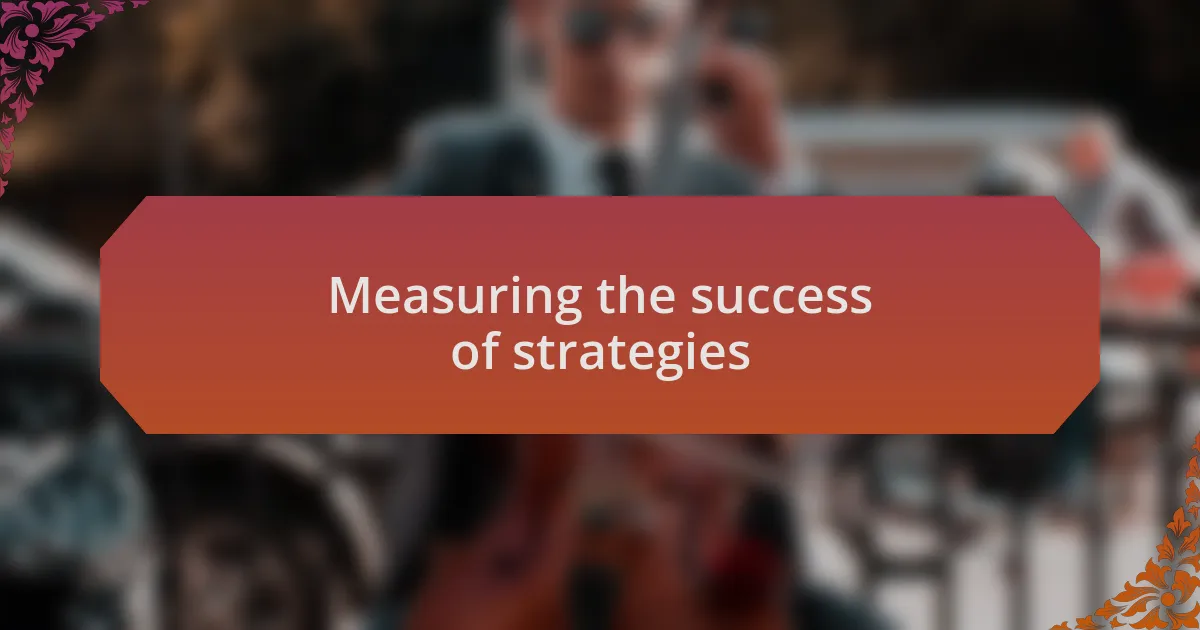
Measuring the success of strategies
Measuring the success of personalization strategies involves tracking various key performance indicators (KPIs). For instance, I once launched a targeted email campaign offering fans exclusive content based on their listening habits. By monitoring open rates and click-through rates, I realized that personalized content significantly increased fan engagement compared to generic updates. Isn’t it fascinating how a tailored approach can lead to more meaningful interactions?
Another effective method I’ve employed is analyzing social media engagement. After implementing a strategy where I highlighted different artists each week, I closely observed the rise in likes, shares, and comments. This real-time feedback allowed me to adjust my approach quickly, ensuring that I consistently met the evolving preferences of my audience. Have you ever noticed how a small change in content can spark a bigger conversation?
Lastly, collecting feedback directly from fans has proven invaluable. I remember conducting surveys post-event, asking attendees what aspects resonated with them the most. The insights I gained guided my subsequent strategies, proving that listening to our community is just as crucial as any quantitative measure. How often do we underestimate the power of simply asking our audience for their thoughts?